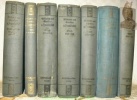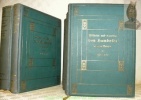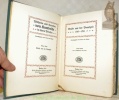27 books for « humboldt wilhelm von »Edit
-
Century
19th (8)
20th (10)
21st (2)
-
Countries
Denmark (5)
France (14)
Spain (1)
Switzerland (7)
-
Syndicate
ILAB (22)
NVVA (3)
SLACES (3)
SLAM (11)
Topics
- Architecture (1)
- Esther (1)
- German literature (4)
- Germanic languages (6)
- Germany (2)
- Goethe johann wolfgang (1)
- Graphic art (1)
- History (4)
- Literature (2)
- Memories (3)
- Mexico mayas (1)
- Paris (1)
- Philology (1)
- Philosophy (3)
- Psychology (1)
- Review (1)
- Savignac (1)
- Sciences (3)
- Sciences & technique (1)
- Various (1)
Über die Verschiedenheit des menschlichen Sprachbaues und ihren Einsfluss auf die Geistige Entwickelung des Menschengeschlechts. - [THE PHILOSOPHY OF SPEECH - PMM 301]
Berlin, 1836. 4to. Bound with the original patterned end-papers in a later red leather binding with raised bands and gilding to spine. First and last leaves with a bit of light brownspotting. XI, (1), 511 pp.
First edition of this classic study of human language, which founded the metaphysics of language - Humboldt's philological testament that founded the theory of the structure of language as the expression of the character of the language-speakers. Up until Humboldt and his ""On the Diversity of Human Language..."" [i.e. the present work], language was viewed as a dead means of communication, as a mere thing. With the present work, a completely new approach to language is founded, one that forms the basis of modern linguistics and upon which linguistic thought and philosophy is now based: ""Language is not a finished thing at rest, but something that at every moment emerges, comes into being, and perishes"" it is not so much a dead product, but far more a continuously active production... Language is the forming organ of thought."" (from the present work). Humboldt died while preparing his magnum opus, on the ancient Kawi language of Java, which thus remained a fragment, but which was published the year after his death (1835), in 1836. The present work, the most important of his productions and the final statement of his lifelong study of language, served as a general introduction to this. This lengthy foreword was completed by Humboldt himself and after his death edited by his younger brother, the great traveler and naturalist Alexander von Humboldt. It was published both as a separate treatise, as here, and as the introduction to the ancient Kawi language of Java. ""On the Diversity of Human Language…"" remains one of the most important attempts at drawing philosophical conclusions from comparative linguistics. This founding work of philosophy of speech ""... first clearly laid down that the character and structure of a language expresses the inner life and knowledge of its speakers, and that languages must differ from one another in the same way and to the same degree as those who use them. Sounds do not become words until a meaning has been put into them, and this meaning embodies the thought of a community. What Humboldt terms the inner form of a language is just that mode of denoting the relations between the parts of a sentence which reflects the manner in which a particular body of men regards the world about them. It is the task of the morphology of speech to distinguish the various ways in which languages differ from each other as regards their inner form, and to classify and arrange them accordingly."" (Encycl. Britt.). With this work, Humboldt founds a theory of language that becomes the basis of modern thought on the subject. The basis being the identification of human language as a rule-governed system (and not merely a collection of words and phrases paired with meaning). Chomsky's thory of language, for instance, is based on Humboldt's. Humboldt has also been credited as an originator of other linguistic theories, such as the linguistic relativity hypothesis, and as the originator of the term ""worldview"". As Alfred Dove points out [in ""Portraits of Linguists"", edt. by T.A. Sebeok], the philosophy of language that Humboldt presents in the present work should remind one of the main works by his master, Immanuel Kant, as they present a fundamental critique of the capabilities of language. Humboldt's purely organic theory of the origin and essence of language, of the way it lives and works, not only forms the basis of certain strands of modern linguistics, it fundamentally does away with the entire mechanic comprehension of purely philological doctrine, paving the way for a metaphysical and more complex understanding of language and human nature. Dove compares the success and influence of the linguistic theory of the present work to what happens in the fundamental work ""Kosmos"" by Humboldt's younger brother, Alexander. Both had the ability to unite the bold sweep of the universal tendency of the 18th century with the prudent method of individual scientific investigation of the 19th century. ""In this, his philological testament, Humboldt attempts the classification of peoples according to language. More important than the classification itself was the corollary to it, which seemed to Humboldt to imply that the development of individual languages is affected by physiology, ethnography, history, geography, political and religious relationships, and that stages in the cultural development of peoples leave strongly marked traces in their languages. In the words of A.H. Sayce, a great philologist of our own day: ""This essay first clearly laid down that the character and structure of a language expresses the inner life and knowledge of the speakers, and that languages must differ from one another in the same way and to the same degree as those who use them... What Humboldt terms the inner form of the language is just that mode of denoting the relations between the part of a sentence which reflects the manner in which a particular body of men regards the world about them.""
Journal parisien (1797-1799).
Solin/Actes Sud, 2001, gr. in-8°, 355 pp, traduit de l'allemand, préface d'Alberto Manguel, notes, index raisonné des noms de personnes, broché, couv. illustrée, bon état
Imprégné des Lumières, Wilhelm von Humboldt séjourne à Paris entre 1797 et 1799. Durant cette période riche et mouvementée, il tient un journal, qu'il conçoit comme une véritable enquête anthropologique. Dans ce dessein, Humboldt rencontre toutes les personnalités marquantes de la capitale : Bonaparte, Sieyès, Mme de Staël, Benjamin Constant, pour ne citer qu'eux. Il fréquente assidûment assemblées, instituts, théâtres et salons ; prend de nombreuses notes de lectures ; dépeint enfin, non sans humour et avec un sens aigu du pittoresque, la société d'alors. Encore inédit en France, le journal parisien est un document exceptionnel sur la vie politique et culturelle sous le Directoire. Il contribuera à faire découvrir au public français, à travers un chapitre de sa propre histoire, la richesse de la pensée de Humboldt et sa profonde originalité.
Briefe Alexander von Humboldt an seinen Bruder Wilhelm. Hrsg. v. d. Familie von Humboldt in Ottmachau.
Stuttgart, Cotta, 1880 in-8vo, LXXXVIII (Einleitung) + 228 S., Original-Broschüre Rücken mit Papier verstärkt. (S. teilw. lose. Ex. zum Binden). Softcover.
I) Aus der Zeit - der Reise in Amerika / II) - des Aufenthalts in Paris / III) - der Reise in Russland / IV) Anhang.

(SLACES, NVVA)
Phone number : 41 (0)26 3223808
Briefe von Wilhelm von Humboldt an eine Freundin. Zweite unveränderte Auflage. 1.-2. (2 Bde).
Leipzig, Brockhaus, 1848. 2 contemp,. hcalf. Raised bands, blindtooled decor. on spine. XIV,381XXII,312 pp. a. 1 facsimile. Clena and fine.
BRIEFE VON WILHELM VON HUMBOLDT AN EINE FREUNDIN
F. A. Brockhaus, Leipzig. 1874. In-12. Relié. Etat d'usage, Couv. légèrement passée, Dos fané, Mouillures. 504 pages. Fac-similé en noir et blanc en frontispice. Texte en allemand et en caractères gothiques. Titres et motifs dorés sur le dos et le 1er plat. Tranche dorée. Etiquette de code sur la couverture. Quelques tampons de bibliothèque. Dos et partie du 1er plat insolés. Quelques rousseurs.. . . . Classification Dewey : 430-Langues germaniques. Allemand
Vierte Auflage der Ausgabe in Einem Bande. Mit einem facsimile. Classification Dewey : 430-Langues germaniques. Allemand
Wilhelm von Humboldt. Lebensbild und Charakteristik.
Berlin, 1856. Cont. boards. Back loosening. XIV,641 pp. Brownspotted.
WILHELM VON HUMBOLDTS BRIEFE AN EINE FREUNDIN
Insel-Verlag. 1924. In-12. Relié. Etat d'usage, Tâchée, Dos satisfaisant, Mouillures. 304 pages. Texte en allemand et en caractères gothiques. Titre et motif dorés sur le dos, et titre doré sur le premier plat. Plats fortement défraîchis.. . . . Classification Dewey : 430-Langues germaniques. Allemand
Ausg. und herausg. von Albert LEITZMANN. Classification Dewey : 430-Langues germaniques. Allemand
Ueber die Buchstabenschrift und ihren Zusammenhang mit dem Sprachbau.
(Köln, Galerie Der Spiegel, 1965). Schmal-8°. (2) weisse Bl., 34 S., (3) Bl. Mit einer lose beiliegenden Serigraphie von Victor Vasarely, rot/blau auf schwarz. Orig.-Broschur.
Spindler 153, 34. - Eines von 600 Exemplaren gedruckt von den Werkstätten der Galerie als Neujahrsgabe. - Broschur leicht verfärbt, sonst schönes Exemplar.
Briefe an eine Freundin. [Charlotte Diede]. Zum ersten Male nach den Originalen herausgegeben von Albert Leitzmann.
3. Auflage. 2 Bände. Leipzig im Insel-Verlag. 1910. 8°. Frontispiz, Titelblatt, XX, 405 S., 1 Bl.; 2 Bl., 426 S., 3 Bl. Originallederbände mit Rückenvergoldung und Kopfgoldschnitt.
Sarkowski 815. - Titel und Einband von F.H. Ehmcke. - Kanten berieben.
Briefe an eine Freundin. Zum ersten Male nach den Originalen herausgegeben von Albert Leitzmann.
3. Auflage u. 2. Auflage. 2 Bde. Leipzig, Insel, 1910. 8°. 405 S.; 426 S., (4) S. (Anzeigen). Goldgepr. Orig.-Lederbde. mit reicher Rückenvergoldung u. Kopfgoldeschnitt (berieben u. leicht fleckig).
Mit Namenszug auf den Titeln. - Leicht gebräunt.
Briefe von...an eine Freundin. 1.-2. Theil.
Leipzig, Brockhaus, 1847. Orig. printed wrappers. Wr. with minor tears. Uncut. XXIV,381,XXII,312 pp. a. 1 facs. Slightly brownspotted.
First edition.
Journal Parisien (1797-1799). Traduit de l'allemand par Elisabeth Beyer. Préface d'Alberto Manguel.
Arles, Solin, Actes Sud, 2001. 352 pages. (24,5x14,5cm). Broché. Couverture illustrée de l'éditeur. Légers défauts d'usage. Très bon état.
Briefe an eine Freundin. 13. Aufl.
Leipzig, F. A. Brockhaus, 1898, gr. in-8°, Front.-Portr. + LVIII + 513 S. + + Faks. + 2 Taf., O.-Lwd. mit reicher klassizistischer Vergoldung, Kapitale, Gelenke und Ecken leicht berieben, Goldschnitt.

(SLACES, NVVA)
Phone number : 41 (0)26 3223808
Briefe an einer Freundin. Dreizehnte Originalauglage. Leipzig, Brockhaus, 1898.
Orig. pictorial cloth, richly gilt. All edges gilt. LVIII,513 pp. Illustr.
Über Schiller und den Gang seiner geistesentwicklung.
Insel-Verlag. 1830. In-12. Relié. Bon état, Couv. convenable, Dos satisfaisant, Quelques rousseurs. 59 pages.. . . . Classification Dewey : 430-Langues germaniques. Allemand
Classification Dewey : 430-Langues germaniques. Allemand
IDEEN ZU EINEM VERSUCH, DIE GRENZEN DER WIRSAMKEIT DES STAATS ZU BESTIMMEN
Philipp Reclam Jun.. 1991. In-16. Broché. Bon état, Couv. convenable, Dos abîmé, Intérieur frais. 223 pages. Annotations et passages soulignés. Ouvrage en allemand.. . . . Classification Dewey : 430-Langues germaniques. Allemand
Classification Dewey : 430-Langues germaniques. Allemand
BRIEFE AN EINE FREUNDIN
F. A. Brockhaus. 1883. In-12. Cartonnage d'éditeurs. Bon état, Couv. convenable, Dos satisfaisant, Quelques rousseurs. 513 pages. Fac-similé en noir et blanc en frontispice. Texte en caractères gothiques. Tranche dorée. Annotations au crayon en page de garde. Annotations d'époque en page de faux-titre (ex-libris).. . . . Classification Dewey : 430-Langues germaniques. Allemand
Elfte Auflage. Mit einem facsimile, neuem Vorwort und Sach- und Namenregister. Classification Dewey : 430-Langues germaniques. Allemand
Wilhelm und Caroline von Humboldt in ihren Briefen. Hrsg. von Anna von Sydow. 7 Bände.
Berlin, Ernst Siegfried Mittler und Sohn 1910-1916, 245x170mm, Verlegereinband. Guten Zustand.
Pour un paiement via PayPal, veuillez nous en faire la demande et nous vous enverrons une facture PayPal
Atlas géographique et physique de la Nouvelle-Espagne. Vom Verfasser auch kurz benannt: MEXICO-ATLAS. Besorgt von Hanno Beck und Wilhelm Bonacker. = Quellen und Forschungen Zur Geschichte der Geographie und der Reisen, Bd. 6,
Stuttgart, F.A. Brockhaus, 1969, in-Folio, 34 S. (liste des cartes + Einführung und Beschreibung d. Tafeln (in deutscher Sprache) ) + XCII (= 92 p. analyse raisonnée et introduction géographique) (en français) + page de titre de l’édition de 1812 + 28 meist gef. Karten und Ansichten, Original-Leinenband. Orig.-Umschlag (OU leicht fleckig).
Folio, full clothbound with jacket (jacket a bit stained & repaired, no loss - cloth bound book in fine condition). A large and detailed colonial geographical atlas of New Spain (Mexico) by world renowed German naturalist and explorer Alexander von Humboldt, (1769-1859). Reproduced texts printed in French and German after the Atlas du Royaume de la Nlle-Esp. (1812) & Atlas du Nouveau continent (Paris 1814) & (Plate 28: Volcan de Jurolla): Vue des Cordillères Paris 1810. This edition complete with 28 plates (Liste of plates on demand). image disp.

(SLACES, NVVA)
Phone number : 41 (0)26 3223808
Diario de viaje a Espana 1799-1800.
Como nos vieron catedra. 1998. In-8. Broché. Bon état, Couv. convenable, Dos satisfaisant, Intérieur frais. 260 pages - nombreuses illustrations en noir et blanc hors texte - livre en espagnol.. . . . Classification Dewey : 460-Langues espagnole et portugaise
Edicion y traduccion de Miguel Angel Vega (IULM y T). Classification Dewey : 460-Langues espagnole et portugaise
Introduction à l'oeuvre sur le Kavi et autres essais - Collection l'ordre philosophique.
Seuil. 1974. In-8. Broché. Etat d'usage, Tâchée, Dos satisfaisant, Intérieur frais. 437 pages - petite trace de stylo bleu sur le 1er plat - couverture légèrement jaunie.. . . . Classification Dewey : 100-PHILOSOPHIE ET DISCIPLINES CONNEXES
Collection l'ordre philosophique - traduction et introduction de Pierre Caussat - Sommaire : La vie - le projet difficile - simples jalons - le choux des textes traduits - appendices - chronologie de la vie - oeuvres linguistiques - editions de la verschiedenheit - oeuvres traduites ou publiées en français - la tâche de l'historien - la recherche linguistique comparative - le duel - introduction à l'oeuvre sur le Kavi. Classification Dewey : 100-PHILOSOPHIE ET DISCIPLINES CONNEXES
Journal parisien (1797-1799) - Collection Solin.
Actes Sud. 2001. In-8. Broché. Bon état, Couv. convenable, Dos satisfaisant, Intérieur frais. 352 pages.. . . . Classification Dewey : 830-Littératures des langues germaniques
Collection Solin - Traduit de l'allemand par Elisabeth Beyer - Préface d'Alberto Manguel. Classification Dewey : 830-Littératures des langues germaniques
"Kleine Schriften. Eine Auswahl aus den geistesgeschichtlichen Aufsätzen (Collection ""Reclams Universal Bibliotek"", n°6922-6924)"
Reclam. 1928. In-12. Broché. Etat passable, 2ème plat abîmé, Dos plié, Papier jauni. 205 pages. Texte en allemand. Rousseurs. Quelques annotations à l'encre dans le texte. Un ex-libris au crayon sur la page titre. Quelques manques sur le 2e plat et dans le texte, sans incidence sur la lecture.. . . . Classification Dewey : 430-Langues germaniques. Allemand
Classification Dewey : 430-Langues germaniques. Allemand
[Revue] André Dalmas, Rose Ausländer, Jean-Paul Savignac, Jean-Loup Trassard, Shakespeare, Esther Orner, Henry Raynal, Wilhelm von Humboldt...
Reference : 13611
Le nouveau commerce, cahier 64, printemps 1986. In-4°, broché.
Le Nouveau Commerce, Paris, 1986.
In-4°, broché.[13611]
 Write to the booksellers
Write to the booksellers













